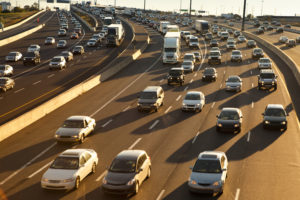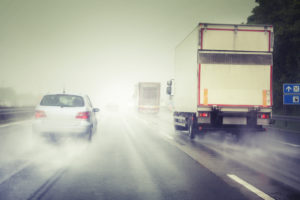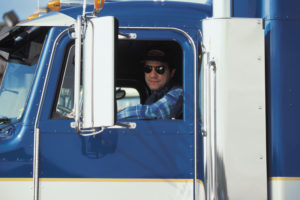5 Summer Safety Tips for Professional Drivers
With more motorists on the road, construction zones and extreme weather, is it any wonder that more occur in the summer than in winter in Alberta?
Driver error accounts for over 80 per cent of all accidents in Alberta, meaning even the most seasoned professional driver can benefit from a refresher on how to reduce the risk of collisions. So, here are five tips to help you safely navigate common summer driving hazards:
Be Ready for Increased Traffic
Summer is synonymous with vacation, which leads to a greater number of motorists and pedestrians on the road including RVs, motorcyclists and bicyclists. Stay alert, drive for the speed of traffic and leave ample space between vehicles. Check traffic conditions before you hit the road, so you are aware of any delays—you may want to alter your route or drive times, if possible, to avoid congestion and popular vacation routes.
Use Caution in Construction Zones
Summer is road construction season in Alberta. Accept that there will be delays on your route and be prepared for common construction zone hazards, such as lane closures, detours, and workers and machinery on the road. Here are some tips to follow when you are approaching, in and leaving a construction zone:
- Start to gradually slow down as you approach a construction zone and merge early if there are lane closures or changes.
- Follow the posted speed limit (and slow down further if conditions dictate), watch for workers and machinery on the road, and steer clear of construction barrels and cones.
- Only start to accelerate once you’ve seen signage that clearly states you have left the construction zone.
Prepare for the Weather
Summer in Alberta brings more than just sunshine; it also brings heavy rain and flooding, hail, high winds and even smoke from forest fires. When extreme weather hits, slow down, increase your distance from the vehicle in front of you, turn on your headlights and taillights, and turn off cruise control. You can also find a safe place to pull over to wait for the weather to settle.
Here are some additional tips for how to safely drive through heavy rain, hail, wildfire smoke and high winds:
Heavy rain and hail
- Try to drive in the tracks of the vehicle in front of you.
- Never stop in traffic lanes below bridges—this is a serious crash risk.
- Do not attempt to drive through moving water (it could sweep your vehicle off the road) or standing water (it could be much deeper than it looks).
Wildfire smoke
- Use your low-beam headlights or fog lights.
- Keep your windows rolled up and use the recirculate air option so smoke doesn’t enter your vehicle.
High winds
- Keep both hands firmly on the wheel and be prepared for sudden bursts of wind when passing buildings, underpasses and larger vehicles.
- Stay alert and be on the lookout for debris on the road as well as other vehicles that may be struggling to stay in their lanes due (semis and bigger trucks are especially suspectable to weaving and toppling in high winds).
- Make sure all vehicle doors and any exposed items are securely fastened before you hit the road.
Always check the weather forecast before you head out to reduce the chances that Mother Nature will take you by surprise.
Take Care of Yourself
Heat and sunshine present several health hazards for professional drivers, including sunburns, dehydration and eye damage. Use these tips to protect your wellbeing when behind the wheel:
Use Sun Protection
Vehicle windows are no match for UV rays. Repeated UV exposure does more than lead to the dreaded “trucker’s arm,” where one forearm is more tanned than the other; it also increases the risk of skin cancer. Take care of your skin by applying sunscreen multiple times throughout the day (particularly to your face, neck, arms and hands) and wearing lightweight clothing that provides UV protection.
Protect Your Eyes
Sun glare can limit visibility, making it difficult to see other vehicles, hazards and obstacles on the road. Wearing a pair of polarized sunglasses will help cut down the glare and protect your eyes from sun damage. If possible, also avoid driving when sun glare is the most problematic, typically around an hour before sunset and an hour after sunrise.
Stay Hydrated
As temperatures climb, so does the risk of dehydration, heat exhaustion and heat stroke. Make sure to bring and drink plenty of water throughout your drive. Also familiarize yourself with the symptoms of dehydration and heat-related illnesses, which can include headaches, dizziness and muscle cramps. Knowing what to watch for can help you determine if you need to seek medical attention.
Commercial Auto Insurance in Alberta
While the number of motor vehicle accident fatalities have decreased in Canada in recent years, there has been a rise in accident litigation across the country.
If your business has registered any vehicles or you use any class of vehicle for business purposes—no matter if you’re driving to visit clients or if you own and operate a transportation company—we recommend you have commercial auto insurance.
There are three main types of commercial auto insurance coverage:
- Third-party liability: Covers damage and injuries to others if you or one of your drivers are at-fault in an accident. It can also cover legal expenses if you’re sued after such a collision.
- Collision: Covers physical damage to your company vehicle(s) if you or one of your drivers are involved in an accident (both at-fault and no-fault).
- Comprehensive: Covers physical damage to your company vehicle(s) caused by incidents other than accidents, such as theft, fire and storms.
There are also coverages available if you transport customers, cargo, dangerous goods and more.
Please contact your insurance advisor to discuss your policy and insurance needs today.
Related reading:



